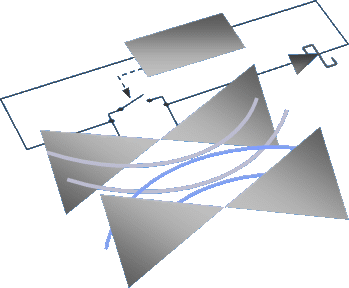Augmented Reality is more than Virtual Reality
The 1st implant...
Have you ever looked into your USB stick? Maybe it has a transparent housing, then you already know that this many-gigabytes-chip is smaller than your fingernail. It can keep data without energy supply, needs very little to write them, and actually the real chip is even smaller than the case around it and does not have to be thicker than a few microns. Every 2 years (any single year recently), the storage capacity of these chips doubles, with hardly any end in sight. Soon we will be able to buy Terabyte chips this small.
What if we use this as the 'harddrive' of our vision glasses, and what if we make it external, a removable device holding all of the glasses' data and programs (except for its basic operating system maybe, providing the hardware drivers)?
Such a concept has appeared with notebooks, and it could be the future there.
Such a tiny chip would not have to go to our key bundle. It could as well be slipped under the skin, near the glasses, and it could be supplied with energy and communicate by radio waves.
A weird idea at a first glance maybe, wouldn't we become androids this way, couldn't someone pervert this gadget into a surveillance instrument, even an electronic ankle bracelet?
And how could this thing gets its energy, how could it communicate, and wouldn't it be inconvenient anyway?
Lets start with convenience: Silicon chips do only need to be microns thin, and then they become extremely flexible. Something like this could be embedded into some tissue friendly material, it could also for example have a comb like structure instead of a square, being able to slip under the skin without disrupting nerves and other structures.
Next, energy and communications could be solved for, with technology already thought out for RFID: A little antenna on the chip could be switched on and off by a transistor, making it absorb more or less energy. The device would not need to have any circuit capable of processing the actual radio frequency used. It would just modulate the backscatter from a nearby transmitter. Meanwhile, it could also draw energy from there: A simple Schottky diode could rectify the excess RF and supply it to the memory circuit. Schottky diodes are known since decades and can be made of silicon. Hence, even if we use over ten gigahertz for the RF transmission (which would be of advantage as we would need only very small antennas), no exotic semiconductor materials would be necessary with our storage chip.The RF energy could be modulated with gigabits per second at almost zero power consumption on sides of the storage chip. The small energy drawn from the RF could even be sufficient to operate the storage device itself.
Next question: electronic slavery. But this here is just a storage device. We decide what to write onto it and we can control if anyone else has or has tried to write onto it. Just as with a simple USB stick or with an external harddrive.
But what about detectability?
As said, this gadget could only operate when getting a strong RF field. It could hardly be detected from a distance of more than a few inches. Moreover, we could program it to react to certain coded transmissions only. Finally, we would of course always use strong encryption for any data we write onto it (or would we - most people these days are absolutely negligent about these issues with their sticks and notebooks already).
The data as well as the transmissions would never be accessible to third parties. Against force, we could provide fake data sets that would appear with one password while the real ones would appear with another (a strategy present with present personal encryption systems already [Truecrypt], but much more efficient here as nobody actually would know about the real storage capacity of our device).
So this thing would be strictly personal.
Could it perhaps be stolen? Yes, of course, but much less so than with conventional devices, as it had to be operated out, also had to be found first place, and we could as well wear two of them, for redundancy. If someone snatched our vision glasses, just we get another pair, that's it.
Personal passwords our vision glasses would only know temporarily, in volatile memory, and it would actively 'forget' and wipe them of course, as soon as it loses eye contact, i.e. doesn't see our iris pattern for more than a second. It would of course stop to work at all, if taken on by another person...
We could of course integrate more functions in such a chip, use it for identification, payment, as a passport. Then, more complicated questions about personal security and privacy might arise. But that's another thematic, it's additional, and it's optional.
Rolf R. Hainich, October 19, 2008
home more notes order
Copyright © 2006-2011 Rolf R. Hainich; all materials on this website are copyrighted.
Disclaimer: All proprietary names and product names mentioned are trademarks or registered trademarks of their respective owners. We do not imply that any of the technologies or ideas described or mentioned herein are free of patent or other rights of ourselves or others. We do also not take any responsibility or guarantee for the correctness or legal status of any information in this book or this website or any documents or links mentioned herein and do not encourage or recommend any use of it. You may use the information presented herein at your own risk and responsibility only. To the best of our knowledge and belief no trademark or copyright infringement exists in these materials. In the fiction part of the book, the sketches, and anything printed in special typefaces, names, companies, cities, and countries are used fictitiously for the purpose of illustrating examples, and any resemblance to actual persons, living or dead, organizations, business establishments, events, or locales is entirely coincidental. If you have any questions or objections, please contact us immediately. "We" in all above terms comprises the publisher as well as the author. If you intend to use any of the ideas mentioned in the book or this website, please do your own research and patent research and contact the author.

